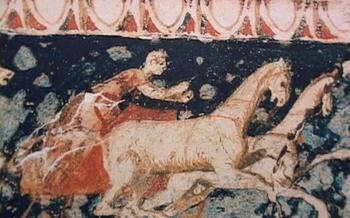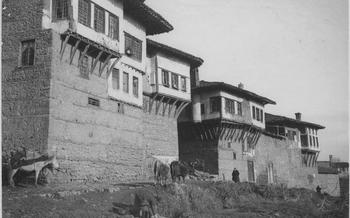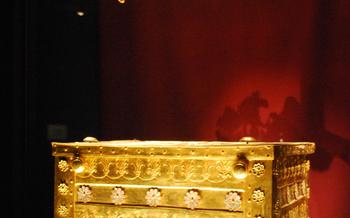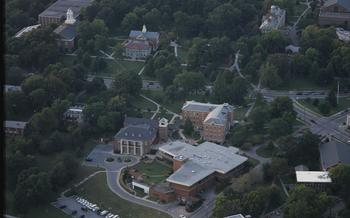
Archaeological Site of Aigai (Vergina)
- History of Vergina (Aigai)
- The Royal Tombs
- The Palace of Aigai
- The Theater of Aigai
- Other Archaeological Sites
- Vergina Museum
- How to Get to Vergina
- Best Time to Visit
- Opening Hours and Admission Fees
- Guided Tours
- What to Wear and Bring
- Where to Eat and Stay
- Other Things to Do in Vergina
- Day Trips from Vergina
- Insider Tip: Unveil the Enchanting Ancient Springs of Loutra Arideas
History of Vergina (Aigai)
The ancient city of Aigai, located in present-day Vergina, holds a prominent place in Greek history as the first capital of the Kingdom of Macedon, established in the 7th century BC. The city flourished under the Macedonian kings, becoming a center of power and culture in the region. Its strategic location at the crossroads of major trade routes contributed to its growth and prosperity.
In the 4th century BC, Aigai reached its peak under the rule of King Philip II, father of Alexander the Great. Philip transformed the city into a magnificent capital, constructing grand palaces, temples, and theaters. He also established the Macedonian army as a formidable force, laying the foundation for Alexander's future conquests.
The city's grandeur was tragically cut short in 336 BC when Philip II was assassinated within the palace walls. His son, Alexander the Great, succeeded him and embarked on his legendary military campaign, spreading the influence of Macedonian culture throughout the ancient world.
Although Aigai's political significance declined after the death of Alexander, it remained an important cultural and religious center throughout the Hellenistic and Roman periods. The city's rich history and legacy were largely forgotten until the late 19th century when archaeological excavations began to uncover its hidden treasures.
The Royal Tombs
The archaeological excavations at Vergina brought to light a series of impressive royal tombs, which are considered among the most significant discoveries in Greek archaeology. These tombs, dating back to the 4th century BC, are located within a large tumulus, or mound, and are believed to belong to members of the Macedonian royal family, including Philip II, father of Alexander the Great.
Inside the tombs, archaeologists uncovered a wealth of gold artifacts, jewelry, and other precious objects, including intricate gold wreaths, jewelry adorned with precious stones, and elaborately decorated weapons. These findings provide valuable insights into the opulence and craftsmanship of the Macedonian court, as well as the wealth and power of the Macedonian kingdom.
The most famous of the tombs is that of Philip II, which was discovered in 1977 by Greek archaeologist Manolis Andronikos. The tomb, which is adorned with stunning wall paintings depicting scenes from Macedonian history and mythology, contained a wealth of artifacts, including a gold larnax, or ossuary, which housed the king's remains. The discovery of Philip II's tomb was a major breakthrough in Macedonian archaeology, as it confirmed the location of the ancient city of Aigai and shed new light on the life and reign of one of the most powerful rulers in ancient history.
The Palace of Aigai
The ancient city of Aigai was not only a center of political power but also a place of great opulence and luxury. The remains of the grand palace complex, once home to the Macedonian kings, offer a glimpse into the lavish lifestyle of the Macedonian royalty.
Although much of the palace has been destroyed over time, the surviving ruins still convey its grandeur and magnificence. The palace complex consisted of several buildings arranged around a central courtyard. The main building, known as the Great Palace, was a large rectangular structure with a monumental entrance. The palace featured elaborate architectural elements, such as Doric columns, marble floors, and intricate mosaics.
The palace was adorned with stunning decorative elements that reflected the artistic prowess of the Macedonians. Wall paintings depicting scenes from mythology and everyday life have been uncovered, showcasing the skill and artistry of the ancient Macedonian painters. The palace also featured sculptures, statues, and other works of art that added to its splendor.
These luxurious surroundings provided a fitting backdrop for the Macedonian kings and their court. The palace was the center of political and social life in Aigai, where the kings received foreign dignitaries, held lavish banquets, and conducted important affairs of state. The palace's opulence and grandeur served to reinforce the power and prestige of the Macedonian monarchy.
The Theater of Aigai
In the heart of ancient Aigai, nestled among the ruins of the once-glorious city, lies the grand Theater of Aigai, a testament to the cultural and artistic achievements of the ancient Macedonians. Excavated in the late 19th century, this magnificent theater stands as one of the largest and best-preserved theaters in Greece, offering a glimpse into the vibrant theatrical traditions of the ancient world.
With a seating capacity of over 5,000 spectators, the Theater of Aigai is a marvel of ancient engineering. Its vast auditorium, carved into the natural slope of a hill, offers a breathtaking panoramic view of the surrounding landscape, making it an ideal setting for both theatrical performances and public assemblies.
The theater's architectural features are a testament to the skill and artistry of its builders. The stage, adorned with intricate reliefs depicting scenes from Greek mythology, serves as a backdrop for the performances, while the orchestra, a circular space in front of the stage, provides ample room for actors and musicians. The seating area, divided into wedge-shaped sections, is supported by a network of vaulted arches, ensuring both comfort and stability for the audience.
During ancient times, the Theater of Aigai played a pivotal role in the cultural life of the city. It hosted a variety of performances, including tragedies, comedies, and musical concerts, which were an integral part of religious festivals and civic celebrations. The theater also served as a venue for political speeches, public debates, and proclamations, reflecting the importance of civic engagement in ancient Macedonian society.
Today, the Theater of Aigai stands as a silent witness to the grandeur of its past. Its imposing structure, weathered by time but still retaining its majesty, invites visitors to step back in time and experience the vibrant atmosphere of ancient Greek theater. Whether attending a modern performance or simply marveling at its architectural splendor, the Theater of Aigai is a must-see destination for anyone interested in history, culture, and the performing arts.
Other Archaeological Sites
In addition to the main archaeological site of Aigai, Vergina boasts several other significant archaeological sites that offer a glimpse into the rich history of the region. One of these is the tumulus of Eurydice, located just a short distance from the royal tombs. This impressive mound is believed to be the burial place of Eurydice II, the wife of King Philip III of Macedon and mother of King Demetrius I. Excavations at the site have revealed a wealth of artifacts, including jewelry, pottery, and weapons, shedding light on the life and times of this ancient queen.
Another important site is the ancient city of Pella, located about 40 kilometers southwest of Vergina. Pella served as the capital of the Kingdom of Macedon for over 200 years, from the 5th century BC until the reign of Alexander the Great. The city was renowned for its grandeur and opulence, and its ruins still bear witness to its former glory. Visitors to Pella can explore the remains of the city walls, the agora, and the royal palace, as well as a number of other impressive buildings. The Pella Archaeological Museum houses a collection of artifacts from the site, including sculptures, mosaics, and pottery.
Vergina Museum
A visit to Vergina is incomplete without exploring the state-of-the-art museum built specifically to house the remarkable artifacts unearthed from the archaeological site. Designed to resemble a Macedonian tomb, the museum boasts a collection that will leave you in awe.
The star attraction of the museum is undoubtedly the golden larnax, or ossuary, of Philip II, the father of Alexander the Great. Discovered intact within the royal tomb, this exquisitely crafted gold casket contains the cremated remains of the Macedonian king. Intricate carvings depicting scenes from Greek mythology adorn the larnax, offering a glimpse into the beliefs and artistic traditions of the ancient Macedonians.
Beyond the golden larnax, the museum showcases a treasure-trove of artifacts that shed light on the opulent lifestyle and cultural achievements of the Macedonian royalty. Gold jewelry, finely crafted weapons, ornate pottery, and bronze sculptures are just a few examples of the priceless objects on display.
The Vergina Museum also features interactive exhibits and multimedia presentations that provide in-depth information about the history, archaeology, and significance of the site. Educational programs and activities are offered throughout the year, making it an ideal destination for visitors of all ages.
How to Get to Vergina
For those eager to discover the wonders of Aigai and immerse themselves in the history of Vergina, the journey begins with transportation. Situated in the heart of Macedonia, Vergina boasts excellent accessibility from major cities in Greece.
From the vibrant metropolis of Thessaloniki, the gateway to northern Greece, Vergina is a mere 75 kilometers away. The scenic drive takes approximately 1 hour and 15 minutes, offering breathtaking views of the Macedonian countryside. Alternatively, travelers can opt for a comfortable train ride, which departs from Thessaloniki's central railway station and arrives in Vergina within 1 hour and 30 minutes.
For those venturing from the capital city of Athens, the distance to Vergina is approximately 500 kilometers. The journey by car takes around 5 hours, providing an opportunity to explore the picturesque landscapes of central Greece. Alternatively, travelers can board a direct flight from Athens International Airport to Thessaloniki, which takes approximately 1 hour. Upon arrival in Thessaloniki, they can proceed to Vergina by train or car, as mentioned earlier.
Navigating Vergina itself is a breeze, with well-maintained roads leading to the archaeological site and the museum. Ample parking is available near the site, ensuring a hassle-free visit for self-driving travelers.
Best Time to Visit
Vergina is a year-round destination, but the best time to visit is undoubtedly during the shoulder seasons, from April to May and from September to October. During these months, the weather is pleasant and mild, with warm days and cool nights. You'll also avoid the sweltering heat and crowds of the summer months, and you'll have a more intimate and enjoyable experience.
If you're visiting during the summer, be sure to plan your sightseeing for early in the morning or late in the afternoon to escape the midday sun. And don't forget to pack sunscreen, a hat, and plenty of water to stay hydrated.
No matter when you choose to visit, Vergina is a fascinating and rewarding destination that offers a glimpse into the rich history and culture of ancient Macedonia.
Opening Hours and Admission Fees
The Archaeological Site of Aigai and the Vergina Museum are open to the public daily from 8:00 AM to 3:00 PM during the summer months (April 1st to October 31st) and from 8:30 AM to 3:00 PM during the winter months (November 1st to March 31st).
Admission fees for both sites are 7 euros for adults, 4 euros for students and senior citizens, and free for children under 18 years old.
Discounts are available for families and groups, and there are also free admission days on certain national holidays and cultural events.
It is recommended to check the official website of the Greek Ministry of Culture and Sports for the most up-to-date information on opening hours, admission fees, and any special events or closures.
Guided Tours
Exploring the archaeological site of Aigai (Vergina) and its museum with a knowledgeable guide can greatly enhance your experience. These tours provide in-depth explanations of the historical significance of the site, the discoveries made, and the artifacts on display. Guides can also offer insights into the daily life, customs, and traditions of the ancient Macedonians.
Guided tours are available in various languages and can be booked in advance online or through local tour operators. Prices typically range from 10 to 20 euros per person. Group discounts may be offered for larger groups.
Booking a guided tour in advance ensures a spot, especially during peak tourist season when demand is high. It also allows you to tailor the tour to your interests and preferences. Some tours may focus on specific aspects of the site, such as the royal tombs or the theater, while others provide a comprehensive overview.
Whether you're a history buff, an archaeology enthusiast, or simply curious about ancient Macedonia, taking a guided tour of Vergina is a worthwhile investment that will deepen your understanding and appreciation of this remarkable site.
What to Wear and Bring
Appropriate Attire: When visiting the archaeological site and the museum, dress respectfully and in accordance with the local culture. Avoid revealing or overly casual clothing. Comfortable footwear is essential, as the site involves a fair amount of walking on uneven surfaces.
Sun Protection: Vergina's sunny climate calls for adequate sun protection. Wear sunscreen with a high SPF and reapply regularly. A hat and sunglasses are also recommended to shield yourself from the sun's rays.
Water and Hydration: Stay hydrated by carrying a water bottle with you. The site offers limited shade, so it's crucial to drink plenty of water, especially during the warmer months.
Camera: Capture your memories with a camera to document your visit to the archaeological site and the museum. The stunning artifacts and historical surroundings provide ample opportunities for photography.
Light Packing: Pack light to make your exploration more comfortable. Avoid carrying heavy bags or backpacks that might hinder your movement around the site.
Where to Eat and Stay
Vergina offers a variety of dining options to cater to different tastes and budgets. For a traditional Greek experience, try one of the local tavernas serving up delicious dishes such as moussaka, pastitsio, and fresh seafood. There are also several cafes and bakeries where you can grab a quick bite or enjoy a leisurely breakfast with a cup of Greek coffee.
When it comes to accommodation, Vergina offers a range of options to suit different preferences. For those on a budget, there are several guesthouses and hostels offering basic but comfortable rooms. For a more luxurious experience, there are a few boutique hotels located in the town center that offer stylish accommodations and amenities.
To truly immerse yourself in the local culture, consider staying in one of the traditional guesthouses in the village of Palatitsia, located just a short walk from the archaeological site. These guesthouses offer a unique opportunity to experience the warmth and hospitality of the Macedonian people while enjoying the tranquility of the countryside.
Other Things to Do in Vergina
For those seeking a deeper immersion into the culture and traditions of Vergina, venturing beyond the archaeological site and the museum offers a wealth of experiences. Local festivals, such as the annual Vergina Festival held in September, showcase traditional dances, music, and local delicacies. Take a leisurely stroll through the picturesque town square, where you can interact with friendly locals and soak up the authentic atmosphere. Discover the vibrant art scene at local galleries, where you can admire the works of talented artists inspired by the region's rich history. Embrace the culinary delights of Vergina by indulging in mouthwatering dishes prepared with fresh, local ingredients at traditional tavernas. Whether you prefer exploring the natural beauty of the surrounding countryside or immersing yourself in the rich cultural tapestry of Vergina, the town offers a diverse range of activities to satisfy every traveler's curiosity.
Day Trips from Vergina
For those seeking to venture beyond Vergina, several intriguing destinations lie within easy reach, offering a diverse range of historical and natural attractions.
Naousa: Just a short drive from Vergina, this picturesque town is renowned for its traditional architecture, cobblestone streets, and vibrant atmosphere. Explore its charming shops, indulge in local delicacies at traditional tavernas, and soak up the lively ambiance of this charming town.
Edessa: Located approximately an hour from Vergina, Edessa boasts stunning natural beauty, including the picturesque Edessa Waterfalls. Marvel at the cascading waters, stroll through the lush parks, and visit the city's historical sites, such as the ancient city of Edessa and the Byzantine churches.
Pella: Once the capital of the ancient Kingdom of Macedon before Aigai, Pella is another must-visit destination. Unearth the remains of the ancient city, including the impressive fortifications, the royal palace, and the well-preserved mosaics that offer a glimpse into the grandeur of Macedonia's past.
Thessaloniki: The vibrant city of Thessaloniki, Greece's second-largest city, is approximately a two-hour drive from Vergina. Immerse yourself in its rich history, explore its iconic landmarks, such as the White Tower and the Rotunda, and savor the delicious local cuisine.
Mount Olympus: For those seeking an adventurous escape, Mount Olympus, the mythical home of the ancient Greek gods, is just a short drive away. Hike through its majestic landscapes, climb to the summit, and witness breathtaking views of the surrounding region.
When planning day trips from Vergina, consider renting a car for the ultimate flexibility and freedom to explore at your own pace. Alternatively, organized tours are available from Vergina, providing transportation and guided commentary to enhance your experience.
Insider Tip: Unveil the Enchanting Ancient Springs of Loutra Arideas
Venture beyond the archaeological treasures of Vergina and immerse yourself in the natural wonders that surround it. Just a short drive away, nestled amidst picturesque landscapes, lies the hidden gem of Loutra Arideas. This charming town is renowned for its therapeutic hot springs, known for their healing properties since ancient times.
Soothe your body and mind as you soak in the warm, mineral-rich waters of the thermal baths. Relax in the serene atmosphere, surrounded by lush greenery and the gentle sounds of nature. Indulge in a rejuvenating spa treatment or massage, drawing inspiration from ancient bathing rituals.
Loutra Arideas also boasts a rich historical heritage, with archaeological sites and landmarks that tell tales of past civilizations. Explore the ruins of an ancient Roman bathhouse, marvel at the intricate mosaics that adorn the floors, and let your imagination transport you back in time.
As the sun sets, take a leisurely stroll along the scenic riverbanks, where you can admire the stunning views and capture breathtaking photographs. Savor the flavors of traditional Greek cuisine at one of the local tavernas, where you can indulge in delicious dishes prepared with fresh, local ingredients.
Whether you seek relaxation, rejuvenation, or a deeper connection to the region's history, Loutra Arideas offers a unique and unforgettable experience that will leave you feeling refreshed, revitalized, and inspired.





